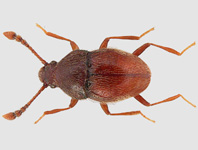Abstract
A second female of mid-Cretaceous Burmaculex antiquus Borkent & Grimaldi, preserved in 99 myo Burmese amber, and the oldest known member of the Culicidae, is described in detail. Although generally opaque and distorted, some character states are added or refined. The discovery of well-developed scales on the legs shows that this feature must now be considered a synapomorphy of both the fossil and all extant members of the family. Previously described synapomorphies and further interpretation here confirm the phylogenetic position of this fossil as the sister group to extant and all known fossil Culicidae. It is placed in the new subfamily Burmaculicinae.
References
Borkent, A. (2008) The Frog Biting Midges of the World (Corethrellidae: Diptera). Zootaxa, 1804, 1–456.
Borkent, A. (2012) The pupae of Culicomorpha—morphology and a new phylogenetic tree. Zootaxa, 3396, 1–98.
Borkent, A. & Grimaldi, D.A. (2004) The earliest fossil mosquito (Diptera: Culicidae), in mid-Cretaceous Burmese Amber. Annals of the Entomological Society of America, 97, 882–888.
http://dx.doi.org/10.1603/0013-8746(2004)097[0882:TEFMDC]2.0.CO;2Briggs, D.E.G. (2013) A mosquito’s last supper reminds us not to underestimate the fossil record. Proceedings of the National Academy of Sciences, 110 (46), 18353–18354.
http://dx.doi.org/10.1073/pnas.1319306110Grimaldi, D. & Agosti, D. (2000) The oldest ants are Cretaceous, not Eocene: Comment. The Canadian Entomologist, 132, 691–693.
http://dx.doi.org/10.4039/Ent132691-5Grimaldi, D. & Engel, M.S. (2005) Evolution of the insects. Cambridge University Press, xv + 755 pp.
Grimaldi, D., Engel, M.S. & Nascimbene, P. (2002) Fossiliferous Cretaceous amber fromBurma (Myanmar): its rediscovery, biotic diversity, and paleontological significance. American Museum Novitates, 3361, 1–72.
http://dx.doi.org/10.1206/0003-0082(2002)361<0001:FCAFMB>2.0.CO;2Harbach, R.E. (2007) The Culicidae (Diptera): a review of taxonomy, classification and phylogeny. Zootaxa, 1668, 591–638.
Harbach, R.E. (2015) Mosquito taxonomic inventory. Available from: http://mosquito-taxonomic-inventory.info/valid-species-list (accessed 23 November 2015)
Harbach, R.E. & Greenwalt, D. (2012) Two Eocene species of Culiseta (Diptera: Culicidae) from the Kishenehn Formation in Montana. Zootaxa, 3530, 25–34.
Harbach, R.E. & Knight, K.L. (1980) Taxonomists' glossary of mosquito anatomy. PlexusPublishing, Marlton, New Jersey, 415 pp.
Hartkopf-Fröder, C., Rust, J., Wappler, T., Friis, E.M. & Viehofen, A. (2011) Mid-Cretaceous charred fossil flowers reveal direct observation of arthropod feeding strategies. Biology Letters, 8, 295–298.
http://dx.doi.org/10.1098/rsbl.2011.0696Kalugina, N.S. & Kovalev, V.G. (1985) Jurassic Diptera of Siberia [in Russian]. USSR Academy of Sciences, Moscow, 198 pp.
Lee, M.K.W. & Craig, D.A. (1983) Cibarial sensilla and armature in mosquito adults (Diptera: Culicidae). Canadian Journal of Zoology, 61, 633–646.
http://dx.doi.org/10.1139/z83-085Lukashevich, E.D. (2008) Larvae —a key to evolution of Culicoidea (Diptera) in the Mesozoic. Alavesia, 2, 59–72.
McAlpine, J.F. (1981) 2. Morphology and terminology—adults. In: McAlpine, J.F., Peterson, B.V., Shewell, G.E. Teskey, H.J., Vockeroth, J.R. & Wood, D.M. (Coordinators), Manual of Nearctic Diptera. Vol. 1. Research Branch, Agriculture Canada, Monograph No. 27, pp. 9–63.
McIver, S.B. (1972) Fine structure of pegs on the palps of female culicine mosquitoes. Canadian Journal of Zoology, 50, 571–582.
http://dx.doi.org/10.1139/z72-078McIver, S.B. & Charlton, C.C. (1970) Studies on the sense organs on the palps of selected culicine mosquitoes. Canadian Journal of Zoology, 48, 293–295.
http://dx.doi.org/10.1139/z70-048McIver, S.B. & Hudson, A. (1972) Sensilla on the antennae and palps of selected Wyeomyia mosquitoes. Journal of Medical Entomology, 9, 37–45.
http://dx.doi.org/10.1093/jmedent/9.4.337Ogawa, J.R. (2007) Phylogeny of the “Chaoboriform” genera. Doctor of Philosophy thesis, Oregon State University, Oregon, xiv + 256 pp.
Poinar, G. (2006) Retracing the long journey of the insects. American Scientist, 94, 376–378.
Poinar, G. & Poinar, R. (2008) What Bugged the Dinosaurs? Insects, disease, and death in the Cretaceous. Princeton University Press, New Jersey, 296 pp.
Poinar, G.O. Jr., Archibald, B., & Brown, A. (1999) New amber deposit provides evidence of early Paleogene extinctions, paleoclimates, and past distributions. The Canadian Entomologist, 131,171–177.
http://dx.doi.org/10.4039/Ent131171-2Poinar, G.O., Zavortink, T.J., Pike, T. & Johnston, P.A. (2000) Paleoculicis minutus (Diptera:Culicidae) n. gen., n. sp., from Cretaceous Canadian amber, with a summary of describedfossil mosquitoes. Acta Geologica Hispanica, 35, 119–128.
Shi, G.H., Grimaldi, D.A., Harlow, G.E., Wang, J., Wang, J., Yang, M.C., Lei, W.Y., Li, Q.L. & Li, X.H. (2012) Age constraint on Burmese amber based on U-Pb dating of zircons. Cretaceous Research, 37, 155–163.
http://dx.doi.org/10.1016/j.cretres.2012.03.014Szadziewski, R. & Gilka, W. (2011) A new fossil mosquito, with notes on the morphology and taxonomy of other species reported from Eocene Baltic amber (Diptera: Culicidae). Polskie Pismo Entomologiczne, 80, 765–777.
http://dx.doi.org/10.2478/v10200-011-0057-5Szadziewski, R. & Gilka, W. (2014) Fossil records of mosquitoes (Diptera: Culicidae). 8th International Congress of Dipterology, 10–15 August, 2014, Potsdam, Germany, Abstract volume, 360.
Zavortink, T.J. & Poinar, G.O. (2008) Toxorhynchites (Toxorhynchites) mexicanus, n. sp. (Diptera: Culicidae) from Mexican Amber: A New World species with Old World affinities. Proceedings of the Entomological Society of Washington, 110, 116–125.
http://dx.doi.org/10.4289/0013-8797-110.1.116

